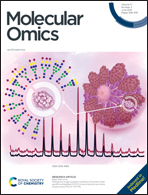Proteome-wide analysis of protein alterations in response to aristolochic acids in rat kidney and liver tissues†
Abstract
Aristolochic acids (AAs), nephrotoxic components of herbs, have been previously demonstrated to cause DNA damage by forming DNA-AA adducts. However, the changes of tissue proteome profiles revealing AA toxicity need to be further studied. We conducted a proteomic study on the kidney and liver tissues of AA treated rats by a shotgun proteomics approach coupled with LC-MS/MS technology. A total of 1543 and 1641 proteins were identified and quantified in the kidneys and liver. Due to AA dosage, 10 and 4 proteins significantly changed in kidneys and the liver after multiple testing correction. Pathway enrichment analysis results were variant in kidneys and the liver. The enrichment analysis of metabolic pathways showed that gene expression and protein biosynthesis disorders were the common causes of AA toxicity to organs. Biological processes that positively responded to AAs in the liver probably have a detoxification function. SEC14-like protein 2 and synaptic vesicle membrane protein VAT-1 homolog were the mostly downregulated proteins in the liver and kidneys respectively.



 Please wait while we load your content...
Please wait while we load your content...